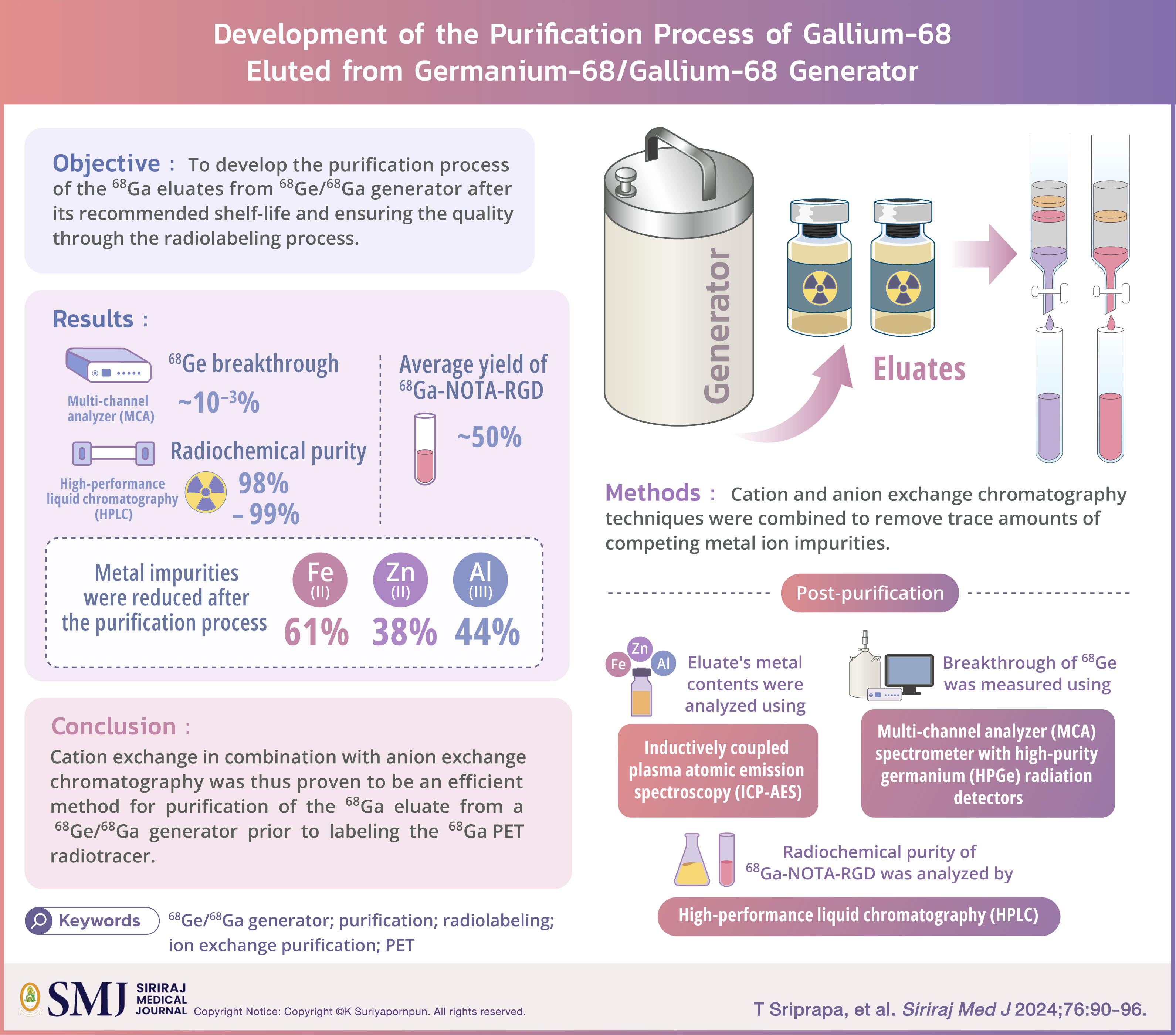Development of the Purification Process of Gallium-68 Eluted from Germanium-68/Gallium-68 Generator
DOI:
https://doi.org/10.33192/smj.v76i2.266113Keywords:
68Ge/68Ga generator, purification, radiolabeling, ion exchange purification, PETAbstract
Objective: 68Ga has a half-life of 68 minutes, with 89% of its decay is through positron emission. It is available from generator systems and possesses suitable property for labeling radioligands. These aspects make 68Ga a promising tracer for positron emission tomography (PET) imaging. This study aims to develop the purification process of the 68Ga eluates from 68Ge/68Ga generator after its recommended shelf-life and ensuring the quality through the radiolabeling process.
Materials and Methods: In this study, we explored the development of a purification method for 68Ga eluted from a
68Ge/68Ga generator before radiolabeling was investigated. Cation and anion exchange chromatography techniques were combined to remove trace amounts of competing metal ion impurities. Post-purification, the eluate’s metal contents were analyzed using inductively coupled plasma atomic emission spectroscopy (ICP-AES). Breakthrough of 68Ge was measured using a multi-channel analyzer (MCA) spectrometer with high-purity germanium (HPGe) radiation detectors. Additionally, the radiochemical purity of 68Ga-NOTA-RGD was analyzed by high-performance liquid chromatography (HPLC).
Results: Metal impurities including Fe(II), Zn(II) and Al(III) were reduced by 61%, 38% and 44% respectively. The 68Ge breakthrough was approximately ~10–3%. The labeling efficiency with NOTA-RGD, a tracer for angiogenesis imaging, resulted in an average yield of 68Ga-NOTA-RGD (not corrected for decay) of around 50%, with a
radiochemical purity by HPLC of approximately 98%–99%.
Conclusion: Cation exchange in combination with anion exchange chromatography was thus proven to be an efficient method for purification of the 68Ga eluate from a 68Ge/68Ga generator prior to labeling the 68Ga PET radiotracer.
References
Banerjee SR, Pomper MG. Clinical applications of gallium-68. Appl Radiat Isot. 2013;76:2-13.
Nelson BJB, Andersson JD, Wuest F, Spreckelmeyer S. Good practices for 68Ga radiopharmaceutical production. EJNMMI Radiopharm Chem. 2022;7(1):27.
Sriprapa T, Doungta T, Sakulsamart N, Taweewatthanasopon N, Madputeh L, Ragchana P, et al. Evaluation of the efficacy and safety of the ITM 68Ge/68Ga generator after its recommended shelf-life. Siriraj Med J. 2023;75(10):752-8.
Dash A, Chakravarty R. Radionuclide generators: the prospect of availing PET radiotracers to meet current clinical needs and future research demands. Am J Nucl Med Mol Imaging. 2023;9(1):30-66.
Hennrich U, Benešová M. [68Ga]-DOTA-TOC: The first FDA-approved 68Ga-radiopharmaceutical for PET imaging. Pharmaceuticals (Basel). 2020;13(3):38.
Özgüven S, Filizoğlu N, Kesim S, Öksüzoğlu K, Şen F, Öneş T, et al. Physiological biodistribution of 68Ga-DOTA-TATE in normal subjects. Mol Imaging Radionucl Ther. 2021;30(1):39-46.
Chen C-J, Chan C-H, Lin K-L, Chen J-H, Tseng C-H, Wang P-Y, et al. 68Ga-labelled NOTA-RGD-GE11 peptide for dual integrin and EGFR-targeted tumour imaging. Nucl Med Biol. 2019;68:22-30.
Aghanejad A, Jalilian AR, Ardaneh K, Bolourinovin F, Yousefnia H, Samani AB. Preparation and quality control of 68Ga-citrate for PET applications. Asia Ocean J Nucl Med Biol. 2015;3(2):99-106.
Romero E, Martínez A, Oteo M, Ibañez M, Santos M, Morcillo MÁ. Development and long-term evaluation of a new 68Ge/68Ga generator based on nano-SnO2 for PET imaging. Sci Rep. 2020;10(1):12756.
Malyshev KV, Smirnov VV. Generator of sup 68Ga based on zirconium hydroxide. Sov Radiochem. (Engl. Transl.); (United States). 1975;17:1.
de Blois E, Sze Chan H, Naidoo C, Prince D, Krenning EP, Breeman WAP. Characteristics of SnO2-based 68Ge/68Ga generator and aspects of radiolabelling DOTA-peptides. App Radiat Isot. 2011;69(2):308-15.
Rösch F, Knapp FF, Jr. Radionuclide Generators. In: Handbook of Nuclear Chemistry. Springer US, 2011:1935-76.
Arino H, Skraba WJ, Kramer HH. A new 68Ge/68Ga radioisotope generator system. The International Journal of Applied Radiation and Isotopes. 1978;29(2):117-20.
Loc'h C, Mazièré B, Comar D. A new generator for ionic gallium-68. J Nucl Med. 1980;21(2):171-3.
Jeong JM, Hong MK, Chang YS, Lee YS, Kim YJ, Cheon GJ, et al. Preparation of a promising angiogenesis PET imaging agent: 68Ga-labeled c(RGDyK)-isothiocyanatobenzyl-1,4,7-triazacyclononane-1,4,7-triacetic acid and feasibility studies in mice. J Nucl Med 2008;49(5):830-6.
Schultz M, McAlister D, Tewson T, Harvey J, Horwitz P. Evaluation of a new Ge-68/Ga-68 generator for preparing high-purity radiopharmaceuticals for PET imaging. Journal of Nuclear Medicine. 2008;49(1):301.
Zhernosekov KP, Filosofov DV, Baum RP, Aschoff P, Bihl H, Razbash AA, et al. Processing of generator-produced 68Ga for medical application. J Nucl Med. 2007;48(10):1741-8.
Asti M, De Pietri G, Fraternali A, Grassi E, Sghedoni R, Fioroni F, et al. Validation of 68Ge/68Ga generator processing by chemical purification for routine clinical application of 68Ga-DOTATOC. Nucl Med Biol. 2008;35(6):721-4.
Rösch F. 68Ge/68Ga Generators and 68Ga Radiopharmaceutical Chemistry on Their Way into a New Century. J Postgrad Med Edu Res. 2013;47(1):18-25.
Lin M, Ranganathan D, Mori T, Hagooly A, Rossin R, Welch MJ, et al. Long-term evaluation of TiO2-based 68Ge/68Ga generators and optimized automation of [68Ga]DOTATOC radiosynthesis. Appl Radiat Isot. 2012;70(10):2539-44.
Sudbrock F, Fischer T, Zimmermanns B, Guliyev M, Dietlein M, Drzezga A, et al. Characterization of SnO2-based 68Ge/68Ga generators and 68Ga-DOTATATE preparations: radionuclide purity, radiochemical yield and long-term constancy. EJNMMI Res. 2014;4(1):36.
Roesch F. Maturation of a Key Resource – The Germanium-68/Gallium-68 Generator: Development and New Insights. Curr Radiopharm. 2012;5(3):202-11.
Patrascu I, Niculae D. The purification and the quality control of 68Ga eluates from 68Ge/68Ga generator. Romanian Reports in Physics. 2011;63(4):988-96.
Roesch F, Filosofov DV. Chapter 3: Production, radiochemical processing, quality evaluation of Ge-68 in Production of long lived parent radionuclides for generators Ge-68, Sr-82, Sr-90 and W-188. IAEA Radioisotopes and radiopharmaceuticals Series. 2nd Edn., International Atomic Energy Agency, 2010.

Published
How to Cite
License
Copyright (c) 2024 Siriraj Medical Journal

This work is licensed under a Creative Commons Attribution-NonCommercial-NoDerivatives 4.0 International License.
Authors who publish with this journal agree to the following conditions:
Copyright Transfer
In submitting a manuscript, the authors acknowledge that the work will become the copyrighted property of Siriraj Medical Journal upon publication.
License
Articles are licensed under a Creative Commons Attribution-NonCommercial-NoDerivatives 4.0 International License (CC BY-NC-ND 4.0). This license allows for the sharing of the work for non-commercial purposes with proper attribution to the authors and the journal. However, it does not permit modifications or the creation of derivative works.
Sharing and Access
Authors are encouraged to share their article on their personal or institutional websites and through other non-commercial platforms. Doing so can increase readership and citations.














